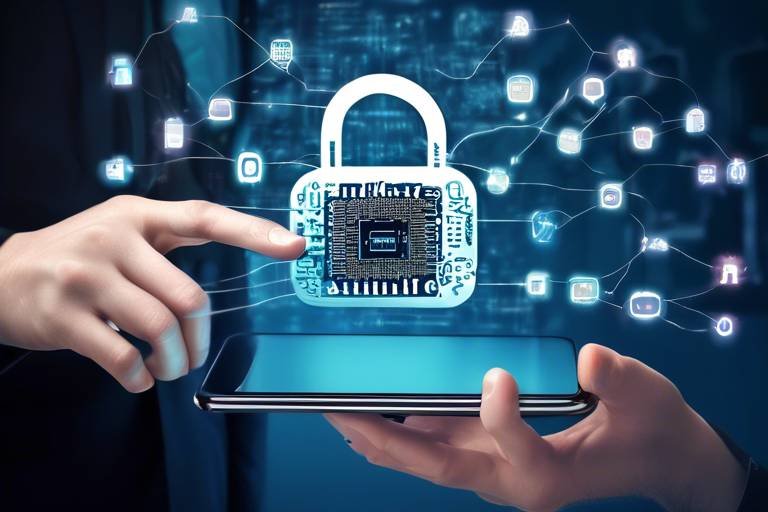The Effect of Data Encryption on Cybersecurity
In today's digital world, where data breaches and cyber threats seem to lurk around every corner, data encryption has emerged as a powerful guardian of our sensitive information. Imagine your personal data as a treasure chest, and encryption is the lock that keeps it safe from prying eyes. But what exactly is data encryption, and why is it so crucial for cybersecurity? This article delves into the pivotal role that encryption plays in enhancing security, examining its benefits, challenges, and the future trends that will shape the landscape of data protection.
Data encryption is the process of transforming information into a format that cannot be easily understood by unauthorized individuals. It’s like putting your secrets in a coded language that only the right people can decipher. There are various types of encryption methods used today, each with its unique characteristics and applications. By converting data into a secure format, encryption ensures that even if data is intercepted during transmission or accessed without permission, it remains unreadable. This section will explore the basic concepts of data encryption and its significance in the realm of cybersecurity.
Why should we care about data encryption? The answer is simple: it is vital for safeguarding sensitive information. In our interconnected world, data is constantly moving—whether it’s being stored on a server or transmitted over the internet. Encryption plays a crucial role in protecting data at rest and in transit. It ensures confidentiality, meaning that only authorized parties can access the information, and integrity, which guarantees that the data has not been altered during its journey. Without encryption, sensitive data like personal identification numbers, financial details, and confidential business information would be left vulnerable to unauthorized access and exploitation.
When it comes to encryption techniques, there are two primary categories: symmetric and asymmetric encryption. Each technique has its strengths and weaknesses, making them suitable for different applications in cybersecurity.
Symmetric encryption uses a single key for both encryption and decryption. This means that the same key must be shared between the sender and the recipient to access the encrypted data. While this method is highly efficient and faster than asymmetric encryption, it comes with its own set of challenges, such as key distribution and management. Common use cases for symmetric encryption include securing data at rest, like files stored on a hard drive, and encrypting communications between trusted parties.
On the other hand, asymmetric encryption utilizes a pair of keys: a public key and a private key. The public key can be shared openly, while the private key must be kept secret. This method is particularly advantageous for secure communications and digital signatures, as it allows users to send encrypted messages without needing to share a secret key beforehand. Asymmetric encryption is the backbone of many secure online transactions and communications, providing an extra layer of security that is essential in today’s digital age.
Many industries are bound by compliance regulations that mandate data protection, making encryption not just a best practice but a legal requirement. Regulations such as the General Data Protection Regulation (GDPR) and the Health Insurance Portability and Accountability Act (HIPAA) enforce strict guidelines on how organizations must protect sensitive data. By implementing encryption, organizations can effectively meet these legal requirements, ensuring that they avoid hefty fines and reputational damage that can arise from data breaches.
While encryption is essential for data security, its implementation can pose several challenges. Organizations often face complexities related to the integration of encryption solutions into existing systems. Additionally, the costs associated with deploying encryption technologies can be significant, especially for smaller businesses. Furthermore, there may be potential performance impacts, as encrypting and decrypting data can slow down system operations. Understanding these challenges is crucial for organizations looking to enhance their cybersecurity posture through encryption.
Even the best encryption technology can fall short if users are not adequately trained. User awareness is crucial for effective encryption. Organizations should prioritize educating employees about encryption practices to mitigate human errors that could compromise data security. This includes understanding the importance of using strong passwords, recognizing phishing attempts, and adhering to best practices for data handling. After all, a chain is only as strong as its weakest link, and in cybersecurity, that link is often the human element.
As cyber threats continue to evolve, so too must encryption technologies. Emerging trends, such as quantum encryption and blockchain-based solutions, are set to shape the future of data security. Quantum encryption leverages the principles of quantum mechanics to create unbreakable encryption methods, while blockchain technology offers decentralized security for data transactions. Organizations must stay ahead of these trends to ensure that their data protection strategies remain robust in the face of new challenges.
- What is data encryption? Data encryption is the process of converting information into a secure format that can only be read by authorized parties.
- Why is encryption important? Encryption is crucial for protecting sensitive information from unauthorized access, ensuring data confidentiality and integrity.
- What are the types of encryption? The two main types of encryption are symmetric encryption, which uses a single key, and asymmetric encryption, which uses a pair of keys.
- How does encryption help with compliance? Encryption helps organizations meet legal requirements for data protection, avoiding penalties and protecting sensitive information.
- What are the challenges of implementing encryption? Challenges include complexity, cost, potential performance impacts, and the need for user education.

Understanding Data Encryption
Data encryption is a fundamental concept in the realm of cybersecurity, serving as a shield that protects sensitive information from prying eyes. In simple terms, encryption is the process of transforming readable data, known as plaintext, into an unreadable format, known as ciphertext. This transformation ensures that only those who possess the correct key can revert the ciphertext back to its original form. Think of it as locking your diary with a key; only you and those you trust have access to its contents.
There are several types of encryption methods employed today, each tailored for specific needs and scenarios. The two primary categories are symmetric and asymmetric encryption. Understanding these methods is crucial for anyone looking to enhance their cybersecurity measures. Let’s break them down:
- Symmetric Encryption: This method uses a single key for both encryption and decryption. It's like having a master key that can lock and unlock a door. While it's efficient and fast, the challenge lies in securely sharing that key.
- Asymmetric Encryption: In contrast, asymmetric encryption employs a pair of keys: a public key, which anyone can access, and a private key, which is kept secret. This is akin to a mailbox; anyone can drop a letter in, but only the mailbox owner can retrieve it with their unique key.
Both methods have their own strengths and weaknesses, and the choice between them often depends on the specific requirements of a given situation. For instance, symmetric encryption is typically faster and suitable for encrypting large amounts of data, whereas asymmetric encryption provides enhanced security for exchanging keys and digital signatures.
In today’s digital landscape, understanding data encryption is not just for IT professionals; it's essential for everyone. As we increasingly rely on online services for banking, shopping, and communication, the need to protect our personal information has never been more critical. Encryption acts as a vital line of defense against cyber threats, ensuring that even if data is intercepted, it remains unreadable and useless to unauthorized users.

The Importance of Data Encryption
In an era where data breaches and cyberattacks are becoming alarmingly common, data encryption stands as a formidable shield safeguarding sensitive information. Imagine your personal data, like bank details or medical records, as a treasure chest. Without encryption, this chest is left wide open, inviting thieves to take whatever they want. But with encryption, it's as if you've locked that chest with a complex key, ensuring only the rightful owner can access its contents. This is the essence of data encryption—it transforms vulnerable data into a secure format that can be deciphered only by authorized individuals.
One of the primary roles of data encryption is to protect data at rest and data in transit. Data at rest refers to information stored on devices, such as servers or databases, while data in transit pertains to information being transferred across networks. Both are critical points where data can be intercepted or compromised. By employing encryption, organizations can ensure that even if data is stolen, it remains unreadable without the proper decryption key. This dual-layered protection significantly enhances the overall confidentiality and integrity of sensitive information, making it much harder for unauthorized users to exploit it.
Furthermore, encryption is not just about keeping data safe; it's also about building trust with customers and stakeholders. When individuals know that their data is encrypted, they feel more secure engaging with businesses, sharing their personal information, and conducting transactions online. This trust can lead to increased customer loyalty and a positive brand reputation, which are invaluable assets in today's competitive landscape.
To illustrate the importance of data encryption, consider the following statistics:
| Statistic | Impact |
|---|---|
| 60% of small businesses close within 6 months of a data breach | Emphasizes the financial risk of not securing data |
| Over 90% of organizations have experienced a data breach | Highlights the prevalence of cyber threats |
| Encryption can reduce the risk of data breaches by up to 80% | Shows the effectiveness of encryption in protecting data |
Moreover, compliance with regulations such as GDPR and HIPAA often necessitates the use of encryption. Organizations that fail to implement adequate data protection measures risk facing hefty fines and legal repercussions. Thus, encryption serves as a critical component not only for security but also for regulatory compliance, ensuring that businesses can operate within the legal frameworks designed to protect consumer data.
In conclusion, the importance of data encryption cannot be overstated. It is an essential practice for protecting sensitive information, fostering trust, ensuring compliance, and ultimately, safeguarding the integrity of digital interactions. As we continue to navigate the complexities of a digital world rife with threats, embracing encryption is not just a choice; it’s a necessity.
- What is data encryption? Data encryption is the process of converting information into a secure format that can only be read by authorized parties.
- Why is data encryption important? It protects sensitive information from unauthorized access, ensuring confidentiality and integrity of data.
- What are the types of encryption? The main types are symmetric encryption, which uses a single key, and asymmetric encryption, which uses a pair of keys.
- How does encryption help with compliance? Many regulations require data protection measures, and encryption helps organizations meet these legal requirements.

Types of Encryption Techniques
When it comes to securing sensitive information, understanding the different types of encryption techniques is essential. Encryption can be broadly categorized into two main types: symmetric encryption and asymmetric encryption. Each of these techniques has its own unique characteristics, benefits, and applications that make them suitable for various scenarios in cybersecurity.
Symmetric encryption is like having a secret handshake that only you and your friend know. In this method, the same key is used for both encrypting and decrypting the data. This makes it incredibly efficient because the process is straightforward and requires less computational power. However, the challenge arises when it comes to key distribution. If someone intercepts the key, they can access the encrypted data. Common algorithms used in symmetric encryption include Advanced Encryption Standard (AES) and Data Encryption Standard (DES).
On the other hand, asymmetric encryption operates on a different principle, akin to using a lock and key system. This technique employs a pair of keys: a public key that anyone can use to encrypt data, and a private key that only the intended recipient possesses to decrypt it. This dual-key system enhances security, particularly in scenarios like secure communications and digital signatures. Notable algorithms in this category include RSA (Rivest-Shamir-Adleman) and ECC (Elliptic Curve Cryptography).
To illustrate the differences between symmetric and asymmetric encryption, consider the following table:
| Feature | Symmetric Encryption | Asymmetric Encryption |
|---|---|---|
| Key Usage | Single key for both encryption and decryption | Pair of keys (public and private) |
| Speed | Faster due to simpler processes | Slower due to complex calculations |
| Key Distribution | Challenging; if intercepted, data is compromised | More secure; public key can be shared openly |
| Use Cases | Data at rest, bulk data encryption | Secure communications, digital signatures |
Both symmetric and asymmetric encryption play pivotal roles in the cybersecurity landscape. While they may serve different purposes, they often work together to create a robust security framework. For instance, a common practice in secure communications is to use asymmetric encryption to exchange a symmetric key, which is then used for the actual data transfer. This hybrid approach combines the strengths of both techniques, ensuring that data remains secure throughout its lifecycle.
In conclusion, understanding these encryption techniques is crucial for anyone looking to enhance their cybersecurity posture. Whether you are a business owner, an IT professional, or just someone interested in protecting your personal data, knowing how symmetric and asymmetric encryption work can empower you to make informed decisions about your data security strategies.

Symmetric Encryption
is a powerful and efficient method of securing data that relies on a single key for both the encryption and decryption processes. Imagine you have a special box that can only be opened with a unique key. You lock your valuable items inside the box, and only you possess the key to unlock it. This analogy perfectly illustrates how symmetric encryption works. The same key is used to scramble (encrypt) your data into an unreadable format and then unscramble (decrypt) it back into its original form when needed. This simplicity makes symmetric encryption one of the most widely used techniques in the realm of cybersecurity.
One of the main advantages of symmetric encryption is its speed. Since the same key is used for both processes, the computational overhead is significantly lower compared to other methods. This makes it ideal for scenarios where large volumes of data need to be encrypted quickly, such as in database encryption or securing data in transit over networks. However, the efficiency comes with a caveat: if the key is compromised, the security of the entire system is at risk. Therefore, managing and protecting the key is paramount.
There are several commonly used symmetric encryption algorithms, each with its own strengths and applications. Some of the most notable include:
- AES (Advanced Encryption Standard): Widely adopted and known for its robustness, AES is used in various applications ranging from securing government data to encrypting files on personal devices.
- DES (Data Encryption Standard): Although largely outdated now due to its shorter key length, DES was once a standard for encrypting sensitive data.
- 3DES (Triple DES): An enhancement of DES, 3DES applies the algorithm three times to each data block, providing a higher level of security.
In practice, symmetric encryption is often used in combination with other security measures to create a layered defense. For instance, it may be paired with asymmetric encryption to secure key exchanges. This hybrid approach leverages the speed of symmetric encryption while ensuring that the keys are transmitted securely using asymmetric methods.
However, it’s not all sunshine and rainbows. The reliance on a single key means that if it falls into the wrong hands, all data encrypted with that key is at risk. Therefore, organizations must implement stringent key management practices to safeguard their encryption keys. Regularly rotating keys, using hardware security modules (HSMs), and employing secure key storage solutions are essential strategies to mitigate these risks.
In conclusion, while symmetric encryption offers speed and efficiency, it also requires diligent key management and security practices to maintain its effectiveness. As cyber threats continue to evolve, understanding the strengths and limitations of symmetric encryption will be crucial for organizations aiming to protect their sensitive information.

Asymmetric Encryption
Asymmetric encryption, often referred to as public-key encryption, is a fascinating method that utilizes a pair of keys: a public key and a private key. Imagine this system as a locked mailbox; anyone can drop a letter into it using the public key, but only the owner of the mailbox can retrieve the letter using their private key. This unique mechanism not only enhances security but also facilitates secure communications over untrusted networks, making it a cornerstone of modern cybersecurity.
The beauty of asymmetric encryption lies in its ability to provide confidentiality and authentication simultaneously. When someone encrypts a message with your public key, only your private key can decrypt it, ensuring that only you can read the message. Conversely, if you want to send a message that verifies your identity, you can sign it with your private key. Anyone with your public key can then verify that the message indeed came from you, adding a layer of trust to communications. This dual functionality is crucial, especially in an era where cyber threats loom large.
Asymmetric encryption is widely used in various applications, including:
- Secure Email Communication: Services like PGP (Pretty Good Privacy) utilize asymmetric encryption to ensure that emails are encrypted and can only be read by the intended recipient.
- SSL/TLS Protocols: When you visit a secure website, asymmetric encryption is used to establish a secure connection between your browser and the web server.
- Digital Signatures: These are crucial for verifying the authenticity and integrity of digital documents, ensuring that they haven't been tampered with during transmission.
Despite its numerous advantages, asymmetric encryption does come with some challenges. For instance, the computational overhead associated with encrypting and decrypting data using asymmetric methods is significantly higher than that of symmetric encryption. This can lead to slower performance, especially when dealing with large volumes of data. However, many systems use a combination of both encryption types—employing asymmetric encryption to securely exchange a symmetric key, which is then used for bulk data encryption. This hybrid approach effectively balances security and efficiency.
In summary, asymmetric encryption offers a robust solution for secure communications, providing both confidentiality and authentication. As we continue to navigate the complexities of the digital world, understanding and implementing asymmetric encryption will be vital for protecting sensitive information from increasingly sophisticated cyber threats.

Encryption and Compliance Regulations
In today's digital landscape, where data breaches can lead to catastrophic consequences, compliance regulations have become a crucial aspect of data management. Various industries, including finance, healthcare, and retail, are governed by strict laws that mandate the protection of sensitive information. Encryption plays a pivotal role in this realm, acting as a shield that not only secures data but also ensures adherence to these regulations.
Regulations such as the General Data Protection Regulation (GDPR) in Europe and the Health Insurance Portability and Accountability Act (HIPAA) in the United States require organizations to implement robust measures to protect personal and health-related data. Failure to comply with these regulations can result in hefty fines and reputational damage. This is where encryption comes into play, offering a practical solution to meet these legal requirements.
For instance, consider the case of a healthcare provider that stores patient records. By encrypting this sensitive data, the organization not only protects it from unauthorized access but also demonstrates compliance with HIPAA regulations. In the event of a data breach, if the information is encrypted, the organization may avoid penalties, as the data is rendered unreadable without the decryption key.
Moreover, encryption is not just about protecting data at rest; it also secures data in transit. When information is transmitted over networks, it is vulnerable to interception. Regulations often require that data be encrypted during transmission to prevent unauthorized access. This means that organizations must adopt encryption protocols such as Transport Layer Security (TLS) to ensure that any data sent over the internet remains confidential.
However, it’s essential to note that compliance is not a one-size-fits-all approach. Different industries have varying requirements, and organizations must tailor their encryption strategies accordingly. For example, financial institutions may need to comply with the Payment Card Industry Data Security Standard (PCI DSS), which has specific encryption mandates for payment data. Understanding these nuances is critical for organizations striving to maintain compliance.
In summary, encryption is a vital component of compliance strategies across various industries. It not only protects sensitive information but also helps organizations navigate the complex landscape of regulations. By implementing effective encryption methods, companies can safeguard their data and ensure they meet the necessary legal requirements, ultimately fostering trust with their customers.
- What is the primary purpose of encryption in compliance regulations?
The primary purpose of encryption in compliance regulations is to protect sensitive data from unauthorized access, ensuring that organizations meet legal requirements and avoid penalties.
- Are all data types required to be encrypted?
No, not all data types are required to be encrypted. The need for encryption depends on the sensitivity of the data and the specific compliance regulations applicable to the organization.
- How can organizations ensure they are compliant with encryption regulations?
Organizations can ensure compliance by staying informed about relevant regulations, conducting regular audits, and implementing encryption strategies tailored to their specific industry requirements.

Challenges of Implementing Encryption
Implementing encryption can feel like navigating a labyrinth—complex and filled with potential pitfalls. While the benefits of encryption are clear, the road to effective deployment is often fraught with challenges. One of the primary hurdles is the technical complexity involved in integrating encryption solutions into existing systems. Many organizations struggle to find the right balance between security and usability, leading to frustration among users and IT teams alike.
Moreover, the cost implications cannot be ignored. Organizations must invest not only in the technology itself but also in the ongoing maintenance and updates necessary to keep encryption protocols robust against emerging threats. This investment can be particularly daunting for small to medium-sized enterprises that may already be operating on tight budgets. As a result, some businesses might delay or even forgo encryption altogether, leaving sensitive data vulnerable to cyberattacks.
Another significant challenge is the potential for performance impacts. Encryption processes can slow down data access speeds, especially when large volumes of data are involved. Imagine trying to drive a sports car through a crowded city; the performance is hindered by the conditions around it. Similarly, while encryption is crucial, it can create bottlenecks in data retrieval and processing, which can affect overall business operations.
Additionally, there's the human factor to consider. User awareness and education play a pivotal role in the effectiveness of encryption. Even the most sophisticated encryption systems can be compromised if employees are not trained on best practices. For instance, if a user inadvertently shares their encryption key or falls for a phishing scam, the entire system's integrity is at risk. This highlights the importance of regular training sessions and updates to keep everyone informed and vigilant.
Finally, organizations must navigate the ever-changing landscape of regulatory compliance. Different industries have varying requirements regarding data protection, and failure to comply can lead to hefty penalties. Encryption can aid in meeting these regulations, but the burden of understanding and implementing the necessary measures can be overwhelming. Organizations must stay updated on legal requirements, which can change frequently, adding another layer of complexity to the encryption implementation process.
In summary, while encryption is a powerful tool in the fight against cyber threats, its implementation is not without challenges. From technical complexities and costs to performance issues and the need for user education, organizations face a multitude of hurdles. However, overcoming these challenges is essential for protecting sensitive data and maintaining trust in an increasingly digital world.
- What is the main challenge of implementing encryption? The primary challenge is the technical complexity and the need for integration with existing systems.
- Does encryption affect system performance? Yes, encryption can slow down data access speeds, especially when dealing with large datasets.
- How important is user education in encryption? Extremely important, as human error can compromise even the strongest encryption systems.
- Are there costs associated with implementing encryption? Yes, organizations must consider the costs of technology, maintenance, and user training.

User Awareness and Education
In the world of cybersecurity, are often the unsung heroes. Imagine a castle with the most fortified walls, yet the gates are left wide open. That's what happens when organizations invest heavily in encryption technologies but neglect to educate their employees about the importance of these measures. Without proper training, even the best security systems can be compromised by simple human errors. It's like having a top-of-the-line alarm system but forgetting to lock the front door!
To truly harness the power of data encryption, organizations must focus on creating a culture of security. This involves not just telling employees what to do, but also engaging them in understanding why these practices are essential. Regular training sessions can be an effective way to instill this knowledge. For instance, workshops that simulate phishing attacks or data breaches can provide hands-on experience, allowing employees to recognize threats in real-time.
Moreover, organizations should consider implementing a comprehensive security awareness program that covers various aspects of cybersecurity, including:
- The importance of strong passwords and how to create them.
- Recognizing phishing emails and suspicious links.
- Understanding the role of encryption in protecting sensitive data.
- Best practices for handling confidential information.
Additionally, organizations can leverage various tools to enhance user awareness. For example, sending out regular newsletters with updates on the latest cyber threats and encryption practices can keep security top-of-mind for employees. Gamification of training modules can also make learning about cybersecurity more engaging and less daunting, turning the often dry subject into an interactive experience.
Ultimately, the goal is to empower users, transforming them from potential vulnerabilities into active defenders of their organization's data. When employees understand the significance of encryption and are equipped with the knowledge to recognize threats, they become a formidable line of defense against cyber attacks. In this ever-evolving digital landscape, investing in user awareness is not just a recommendation; it’s a necessity.
- What is the primary purpose of data encryption?
Data encryption is designed to protect sensitive information by converting it into a secure format that can only be read by authorized parties. - How often should organizations conduct training on encryption?
Organizations should conduct training at least annually, with refresher courses or updates whenever new threats emerge. - Can encryption prevent all cyber threats?
While encryption significantly enhances security, it cannot prevent all threats. It is one layer of a multi-faceted security strategy. - What are some common mistakes users make regarding encryption?
Common mistakes include using weak passwords, failing to update encryption software, and not understanding the importance of encrypting sensitive data.

Future Trends in Data Encryption
As we stride deeper into the digital age, the landscape of data encryption is evolving at a breathtaking pace. With cyber threats becoming increasingly sophisticated, the need for advanced encryption methods is more critical than ever. One of the most exciting trends on the horizon is quantum encryption. This technique leverages the principles of quantum mechanics to create unbreakable encryption. Imagine a world where data is transmitted with such security that even the most advanced hackers would be left scratching their heads! Quantum encryption promises to revolutionize how we think about data security, making it virtually impossible for unauthorized parties to access sensitive information.
Another trend that is gaining traction is the integration of blockchain technology in encryption. Blockchain, known primarily for its role in cryptocurrencies, offers a decentralized method of storing data securely. By using blockchain for encryption, organizations can ensure that data is not only protected but also verified at every step of its journey. This means that any tampering or unauthorized access can be easily detected. The combination of blockchain and encryption is like having a fortified castle with watchtowers; it provides multiple layers of security that can deter even the most determined intruders.
Moreover, artificial intelligence (AI) is also making waves in the field of encryption. AI can analyze patterns and detect anomalies in data access, allowing for real-time adjustments to encryption protocols. This proactive approach is akin to having a security guard who not only watches over the premises but also anticipates potential threats before they materialize. With AI-driven encryption, organizations can stay one step ahead of cybercriminals, adapting their defenses as new threats emerge.
However, as we embrace these innovative technologies, it’s essential to remain vigilant about the ethical implications they bring. With great power comes great responsibility, and organizations must navigate the fine line between security and privacy. The future of data encryption is not just about protecting information; it’s also about ensuring that the methods we use respect individual rights and adhere to regulatory standards.
In conclusion, the future trends in data encryption are not merely about enhancing security but also about transforming how we perceive and manage data in a digital world. By harnessing the power of quantum mechanics, blockchain technology, and artificial intelligence, we stand on the brink of a new era in cybersecurity. As we move forward, it’s crucial to keep an eye on these developments and consider how they can be integrated into our existing frameworks to create a safer digital environment for everyone.
- What is quantum encryption? Quantum encryption uses the principles of quantum mechanics to secure data, making it virtually unbreakable.
- How does blockchain enhance encryption? Blockchain technology provides a decentralized method for securely storing data, allowing for easy detection of unauthorized access.
- Can AI improve encryption methods? Yes, AI can analyze data access patterns to detect anomalies and adapt encryption protocols in real-time.
- What are the ethical concerns surrounding new encryption technologies? Organizations must ensure that their encryption methods respect individual privacy rights and comply with regulatory standards.
Frequently Asked Questions
- What is data encryption?
Data encryption is the process of converting information into a secure format that can only be accessed by authorized individuals. Think of it as locking your sensitive information in a safe that only certain people have the key to.
- Why is data encryption important?
Data encryption is crucial for protecting sensitive information from unauthorized access. It ensures that even if data is intercepted, it remains unreadable and secure, much like a secret code that only you and your trusted friends can decipher.
- What are the different types of encryption techniques?
There are mainly two types of encryption techniques: symmetric and asymmetric encryption. Symmetric encryption uses the same key for both encrypting and decrypting data, while asymmetric encryption uses a pair of keys—a public key and a private key. Each has its own strengths and applications in cybersecurity.
- How does symmetric encryption work?
Symmetric encryption is like having a single key that opens a specific lock. It’s efficient and faster for processing large amounts of data; however, the challenge lies in securely sharing that key with authorized users.
- What is asymmetric encryption?
Asymmetric encryption is more like a mailbox where anyone can drop in letters (using the public key), but only you can access the contents (using the private key). This method enhances secure communications and is widely used for digital signatures.
- How does encryption help with compliance regulations?
Many industries must adhere to strict data protection regulations. Encryption acts as a shield, helping organizations comply with these laws and avoid hefty penalties, much like wearing a hard hat on a construction site to stay safe.
- What challenges come with implementing encryption?
While encryption is vital, implementing it can be tricky. Organizations may face complexities, costs, and potential performance impacts. It's like installing a high-tech security system—it requires planning, investment, and ongoing maintenance.
- Why is user awareness important for encryption?
User awareness is critical because even the best encryption can be compromised by human error. Training employees on encryption practices is like teaching them how to use a fire extinguisher; it prepares them to respond effectively in case of an emergency.
- What are the future trends in data encryption?
The future of data encryption is exciting, with emerging trends like quantum encryption and blockchain-based solutions on the horizon. These advancements promise to enhance security, making it even harder for cyber threats to breach defenses.



















